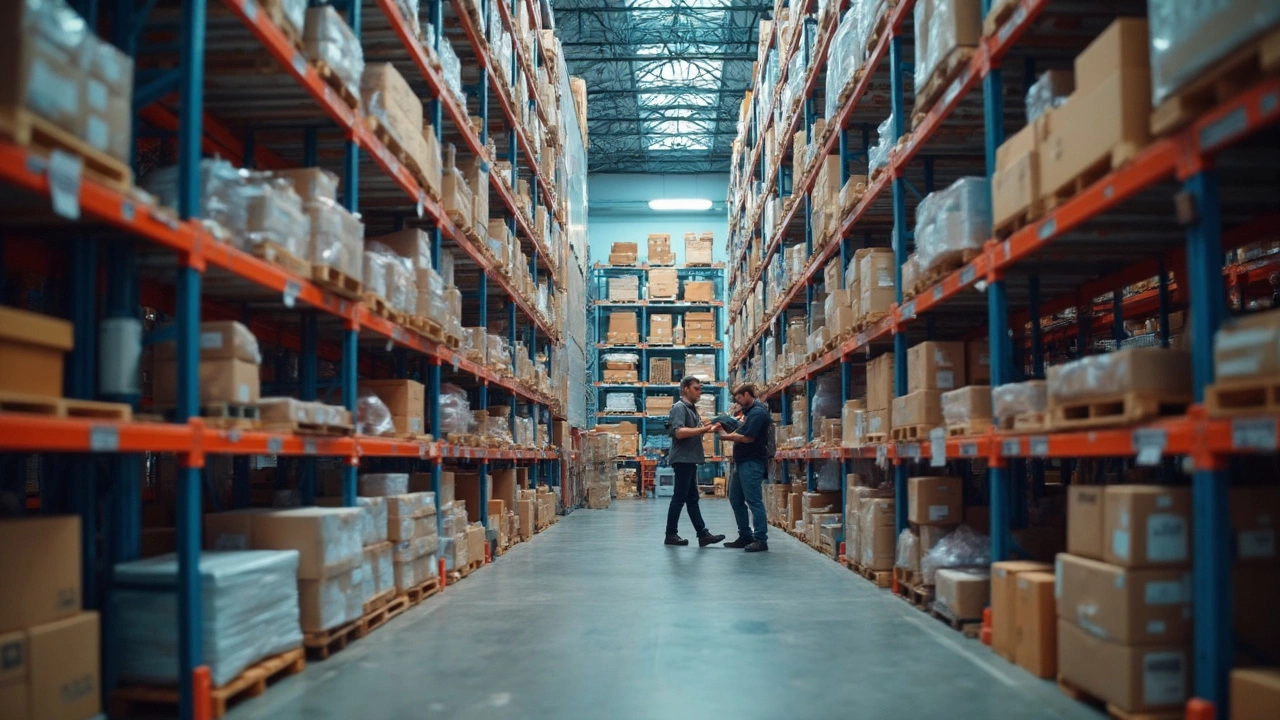eCommerce logistics might sound like a fancy term, but it's really about getting stuff where it needs to go seamlessly. And if you're running an online business, this is like knowing the rules of the game. Picture this: you order something online, and after clicking 'buy now', you probably just wait for it to arrive, right? But behind the scenes, there's a whole orchestra of logistics playing out to make that happen smoothly.
So, what's at the core of all this? It's all about managing the journey of goods from the warehouse to your front door. Efficient warehousing is one part of the puzzle. Think of it like your pantry; you want it organized so you can find what you need without turning the place upside down. The same goes for an eCommerce warehouse. Having a system where products are easy to locate is crucial.
- Understanding eCommerce Logistics
- Efficient Warehousing Strategies
- Optimizing Your Supply Chain
- Tech's Impact on Logistics
- Navigating Last-Mile Delivery
Understanding eCommerce Logistics
Diving into the world of eCommerce logistics can feel like opening a whole new chapter in business. Whether you're just starting out or scaling up, knowing how the behind-the-scenes magic works is crucial. In simple terms, eCommerce logistics covers everything from storing products in a warehouse, packing them up, and shipping them out efficiently to make sure they reach customers on time.
At the heart of logistics is the supply chain, which is like a relay race, only with products instead of batons. It's important to streamline every part of this chain, so your business runs like a well-oiled machine. This means organizing your inventory, choosing the right shipping partners, and making sure you're flexible enough to handle the unexpected, like sudden spikes in orders or supply chain disruptions.
The warehouse, or, as some might call it, the mothership of logistics, plays a vital role. Think about it: how you store your products can make or break your delivery speed. Efficient warehousing involves strategic product placement and inventory management. For instance, stuff that sells fast should be easy to grab and go, while slower-moving items can be stored a bit further back.
- Consider the layout: Make sure it's easy to move around and that products are easy to find.
- Track everything: Know your stock levels at all times to avoid overselling or stockouts.
- Automate where you can: Use technology to streamline processes, like automated picking systems or barcoding systems to improve accuracy.
Then comes the shipping part. This is where choosing the right partners really counts. You wanna team up with carriers that are reliable, cost-effective, and can handle any volume you throw at them. Plus, keep an eye on the latest trends like sustainable packaging or flexible delivery options since customers dig that kind of forward-thinking stuff these days.
So yeah, eCommerce logistics isn't just about moving boxes. It's the backbone of your online business and getting it right can set you up for success. In fact, reports show businesses that invest in logistics can reduce costs by about 10-12%, and that’s no small potatoes!
Efficient Warehousing Strategies
For anyone in the eCommerce logistics game, getting your warehousing strategy right is a game-changer. It's not just about cramming products onto shelves; it's about smooth operations and setting up a system that saves time and money.
First off, think about the layout of your warehouse. An optimized design ensures quick access to popular items, making picking and packing a breeze. Consider a layout where high-demand products are closest to the packing area.
- ABC Analysis: This is like knowing which of your clothes you wear the most. Group your items into three categories: 'A' being the best-sellers, 'C' the least. You focus storage and monitoring efforts on 'A' items because they need to be easily accessible.
- Automated Systems: Technology is your friend here. Automated systems can manage inventory levels, alerting you when stock dips below a certain level, which helps in avoiding stockouts.
Another nifty trick is cross-docking. Picture a relay race: goods come into the warehouse and go out to customers without hanging around—minimal storage, faster delivery. This method can cut costs by reducing handling and storage needs.
Keeping tabs on inventory with regular checks is also crucial. An inventory management system is worth its weight in gold for tracking stock accurately and in real-time. Plus, it helps in forecasting demand more effectively.
Let's not forget worker safety and efficiency. Well-lit spaces with clear paths reduce accidents and help workers move swiftly. And who wouldn't want that in their work environment?
To give you an idea of how much this can impact costs, consider a simple comparison:
| Strategy | Average Cost Saving |
|---|---|
| Optimized Layout | 15% on labor costs |
| ABC Analysis | 20% in storage efficiency |
So, getting your warehouse in order isn't just about keeping things tidy—it's about cutting costs and boosting efficiency. Smart strategies mean happy customers and a happy bottom line.

Optimizing Your Supply Chain
If you're in the eCommerce logistics game, having a slick supply chain is like having a secret superpower. The key is making sure each part, from the supplier to the customer, is a well-oiled machine.
First off, you need to focus on visibility. Knowing where your products are at any given moment is super crucial. You can use tech tools like inventory management software that tracks stock levels in real time. This helps you avoid those awkward 'product unavailable' moments that can hit customer satisfaction hard.
Communication should flow easily between you and your suppliers. Regular updates on inventory levels and shipping statuses keep everyone's expectations aligned. Plus, a good relationship with your suppliers means when things get hectic, like a sudden spike in orders, you're already on the same team.
Ever thought about the shipping options you provide? Offering a range of choices, like standard, expedited, and overnight delivery, can cater to what your audience needs at any given moment. This isn't just about giving more options but also about guaranteeing flexibility in your shipping strategies.
Efficiency plays a big role too. Cross-docking, for instance, is a fancy term for unloading goods directly from incoming trucks to outgoing ones. It reduces storage time and cost while speeding up delivery. This means customers get their goods quicker, and that's a win-win.
Here's a handy snapshot of how these strategies impact your logistics:
| Aspect | Benefit |
|---|---|
| Inventory Management | Reduces overstock and stockouts |
| Supplier Communication | Streamlines operations |
| Shipping Options | Increases customer satisfaction |
| Cross-Docking | Minimizes storage costs |
And no one should forget the data. Analyzing past trends can predict future demands, which is like having a crystal ball for your business. It can guide how you manage stock and even how you market certain items at different times.
The name of the game is making sure every cog in the wheel is turning the right way. At the end of the day, a well-optimized supply chain not only saves money but also heightens the customer's experience, which is what keeps them coming back for more.
Tech's Impact on Logistics
Let's talk tech and how it's shaking up the world of eCommerce logistics. Picture this: a few years ago, logistics was all about paperwork and manual tracking. Fast forward to now, and we've got a buffet of technology making the whole process a breeze. Pretty cool, right?
First up, automation is the name of the game. Whether it's robotic systems in warehouses or automatic sorting in distribution centers, these tech wonders help save time and cut down on errors. That means fewer headaches when you're trying to track down that elusive package. Plus, automation gives you the chance to scale up operations without the usual hiccups.
Then there's the magic of data analytics. Companies dive into heaps of data to spot trends and make decisions that keep the supply chain humming. It's like having a crystal ball, but instead of predicting your future, it's predicting what needs to be stocked and when. It's all about being one step ahead.
And let's not forget about the role of AI and machine learning. These aren't just buzzwords; they're game-changers. They help with things like route optimization for shipping which cuts delivery times and saves money. Imagine telling customers they'll get their package faster than they thought. That's the kind of win that keeps them coming back.
Blockchain is also making waves. This tech brings transparency to transactions, which can be a big deal for customers who want to know exactly where their product is coming from. It's like giving logistics the trust boost it needs in a digital world.
Here’s a quick look at some of these tech trends and their roles:
| Technology | Role in Logistics |
|---|---|
| Automation | Streamlines processes and reduces errors |
| Data Analytics | Predicts supply chain trends for better planning |
| AI and Machine Learning | Optimizes shipping routes |
| Blockchain | Ensures transparency and trust |
So, while tech might sound like the cherry on top, it's really woven into every layer of logistics today. Embracing these advancements isn't just an option; it's practically a requirement to stay competitive in today's fast-paced eCommerce world.

Navigating Last-Mile Delivery
Last-mile delivery sounds simple, but it's actually one of the most challenging parts of eCommerce logistics. It's the final step of getting a package from a distribution center to your customer's doorstep. It's that crucial final stretch where a lot can go wrong, like late deliveries or items getting lost. Nobody wants that, right?
Here's an interesting nugget: Did you know last-mile delivery can make up to 53% of the total shipping costs? That's why it's a huge focus for businesses looking to cut back on expenses while keeping customers happy. So, what's the secret sauce to acing last-mile delivery? A big part of it is staying flexible and leveraging smart tech.
Think about what Amazon does—they've nailed this by using local delivery partners, building out their own network of drivers, and using advanced route optimization tools. This way, they not only speed up delivery times but also cut down on costs, which means happier customers and more savings.
For smaller eCommerce businesses, teaming up with reliable courier services is key. It's also worth investing in delivery management software that can optimize routes, track orders in real-time, and update customers about their shipment status. Customers love being in the loop!
Let's not forget the rise of green delivery. More companies are striving to reduce their carbon footprint; using electric vehicles or bikes for deliveries can be a win-win. It's an eco-friendly move that can boost your brand image.
- Explore partnerships with local courier services for flexibility.
- Invest in delivery management systems for better oversight.
- Consider environmentally friendly delivery methods.
Mastering last-mile delivery is a game-changer. It’s all about being efficient, transparent, and eco-conscious. Your customers will thank you with loyalty, and that's worth its weight in gold.


